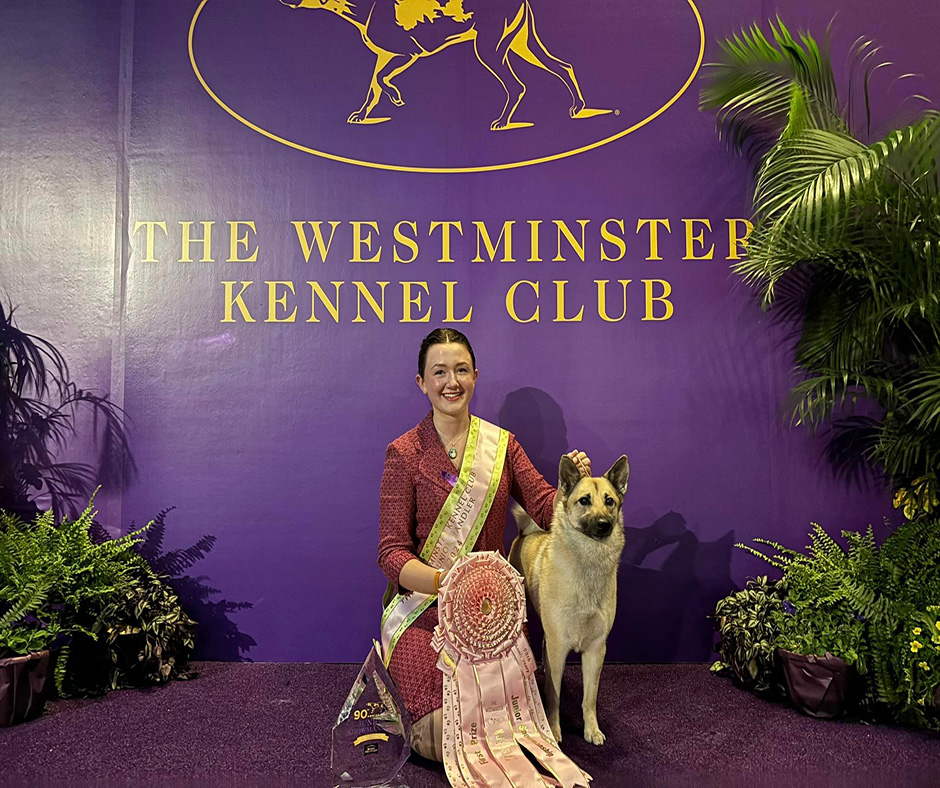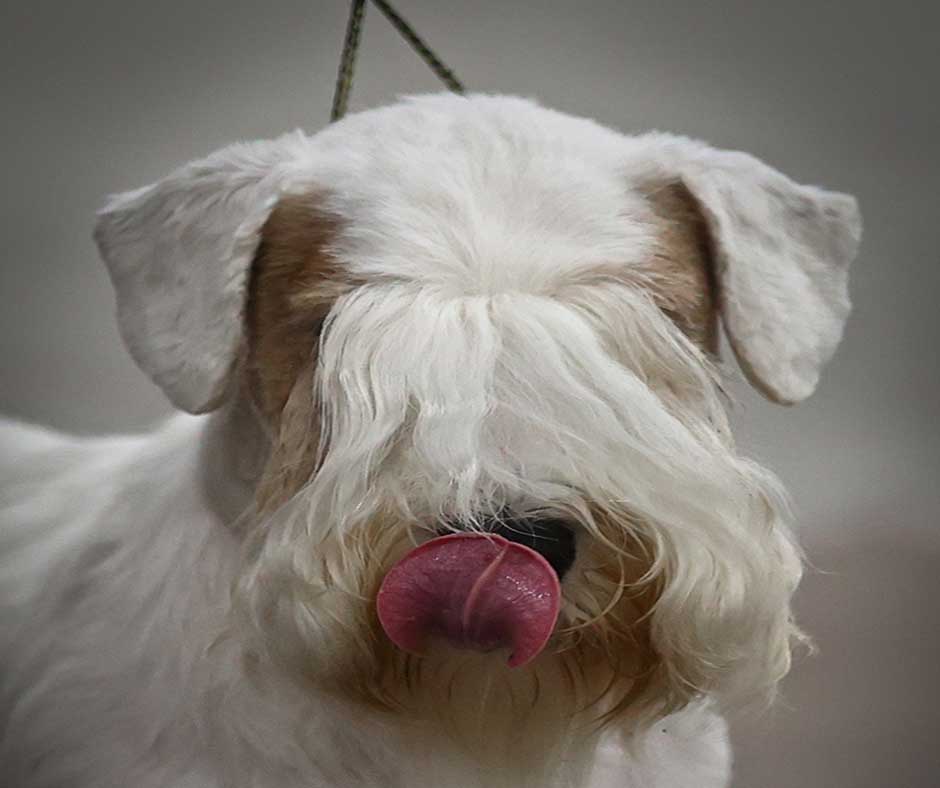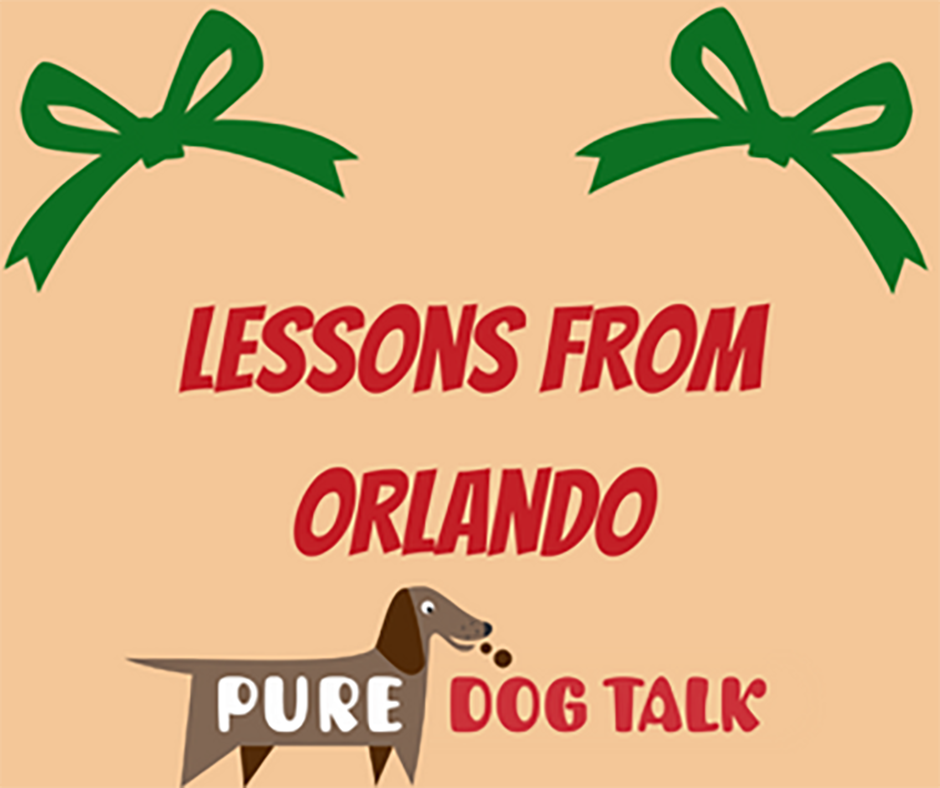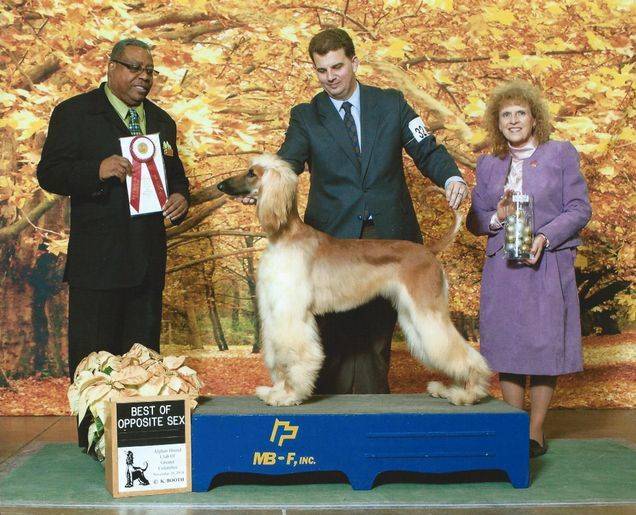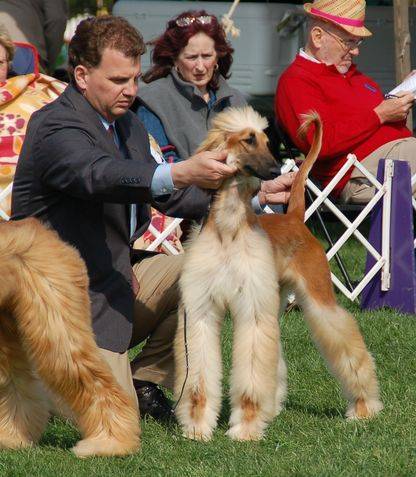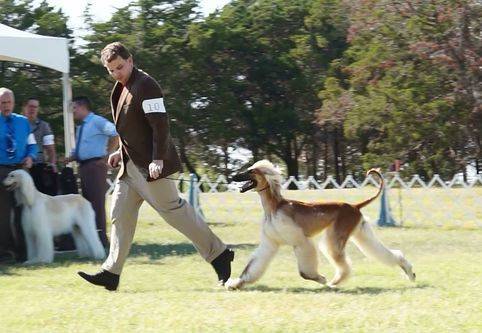638 – Juniors’ Best Advice: Always Strive to Improve
Juniors’ Best Advice: Always Strive to Improve
Octavia Stensen, Best Junior at Westminster Kennel Club this year, joins host Laura Reeves for the behind the scenes story of how a non-dog show kid just capped off the triple crown of junior showmanship, having also won Best Junior at the AKC National Championship and made finals in Juniors at Crufts.
Stensen’s family acquired a Norwegian Buhund when she was 10 years old. Her first time in the ring left her in tears, but she persevered and nine years later she reached the pinnacle of the sport for juniors.
“We ended up getting Fiona and she became our new pet but the one catch of it was that we had to get her grand champion,” Stensen said. “I was like, ‘I’ll do it. I don’t even know what that means but I will do it. I don’t even know what this entails or what I’m doing in this, but I am going to do it.’ And so it started from there and it wasn’t easy by any means.
“I went to bed that night (after my first ring experience) thinking, I can do better and I can do better here and I could have done this and I’m gonna do that next time,” Stensen said. “And there was a next time, you know what I mean? There was like that idea of the future.
“I did eventually get her Grand and she is now our pet and we have since then bred her and got my heart dog out of that, Pineapple.

Octavia Stensen with her mom and Pineapple after the WKC Best Junior win.
“I am so, so lucky both my mom and my dad have been so supportive, but my mom really steps up. My dad is like, I’ll pay the bills, but my mom is like, I’m going to be here next to you and I’m going to travel with you to all of these things and I couldn’t be more grateful for that.
“They have definitely supported me in more ways than I could have ever, ever asked for. I mean, after winning at Orlando and walking out of the ring and then being like, so I guess I need to go to London now. And they were like, ‘okay, so let’s figure out how we’re going to finance that.’
Stensen’s advice to juniors coming up is always have fun and never stop improving.
“It is so, so hard to get caught up in the competition and freaking yourself out and getting all nervous but this is meant to be fun. It’s all for fun. We are coming to these things to have a good time, we’re not coming to these things to torture ourselves with nerves. Listen to your mentors and your peers and you can always be better. You can consistently improve. I mean, there’s never a moment in your life where you can stop getting better at things.”
577 — Margery Good on the Deep Character of “Sillyham” Terriers
Margery Good on the Deep Character of Sealyham Terriers
Margery Good joins host Laura Reeves to share her deep love of her beloved Sealyham Terriers, breeding, grooming and the importance of learning.
Good started in obedience with a German Shepherd Dog.
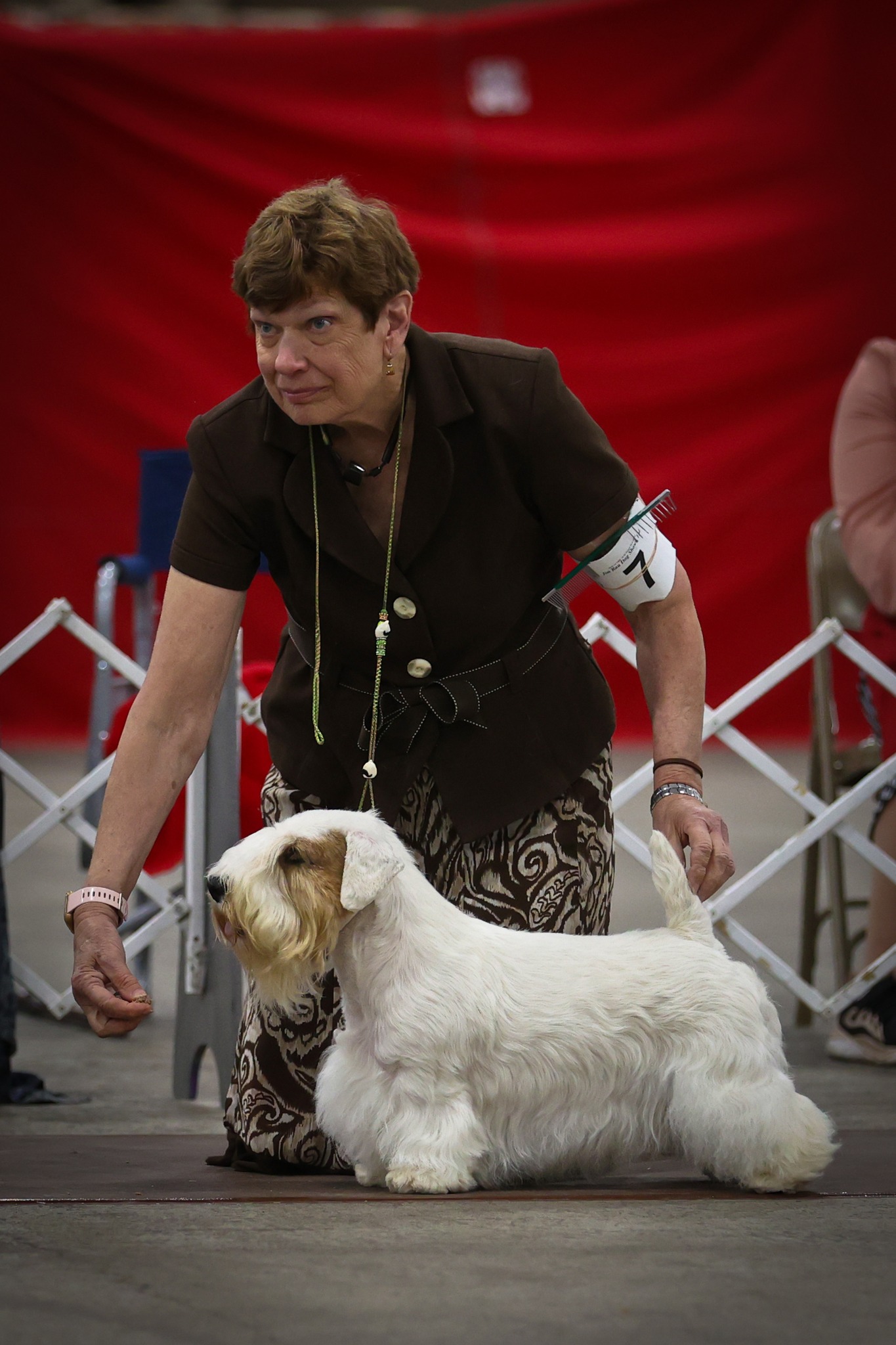
Margery Good with BIS/BISS CH Goodspice Efbe Money Stache
“I entered in obedience, but then I spent my day at the dog show stalking the handlers that were sharing their conformation dogs and trying to learn as much as I possibly could, without getting in their way. Peter Green, Bob and Jane Forsyth. Bill Trainor. People that were at the very top of their careers in those days, and I would spend as many hours as I could watching and trying to learn.
“Well, I watched a lot of their grooming at their setups and how they handled each dog on the tables and putting them on and off the table. how they brushed them, what direction they use or what tools they picked up. Except for the Forsyths, the handlers were only showing like 6-7 dogs in the show and they’d do some trimming the shows.
“So I’d watch how they tweak the trim before they take them in the ring. And then with like the Afghan hounds and Poodles I watched, how did they brush the hair? How did they pick up the hair they weren’t brushing so that they could get from their skin to the tip of the hair. So I picked up a lot of learning from observing how they prepared the dogs. And then I’d go and watch them actually showing the dog. I actually spent more time behind the scenes than by the rings.
Speaking to the challenge of trimming Sealys, Good said “I do try very hard to breed dogs with coats that normal groomers and average dog owners, if they apply themselves, they can work and have their successful finish to them. I also spend a lot of time helping people at shows or at my place or wherever I am to help them tidy up their trims and show them a new technique that they haven’t tried or encourage them to keep going until they get it right.
“Now that we have things like cell phones, I say take pictures, send me pictures, I will critique your trim. I work with people, they’re 12-15 hours away. If they send me pictures, I will help. And it works.
Sealyham Terriers – Generous, Big Dogs in Small Package
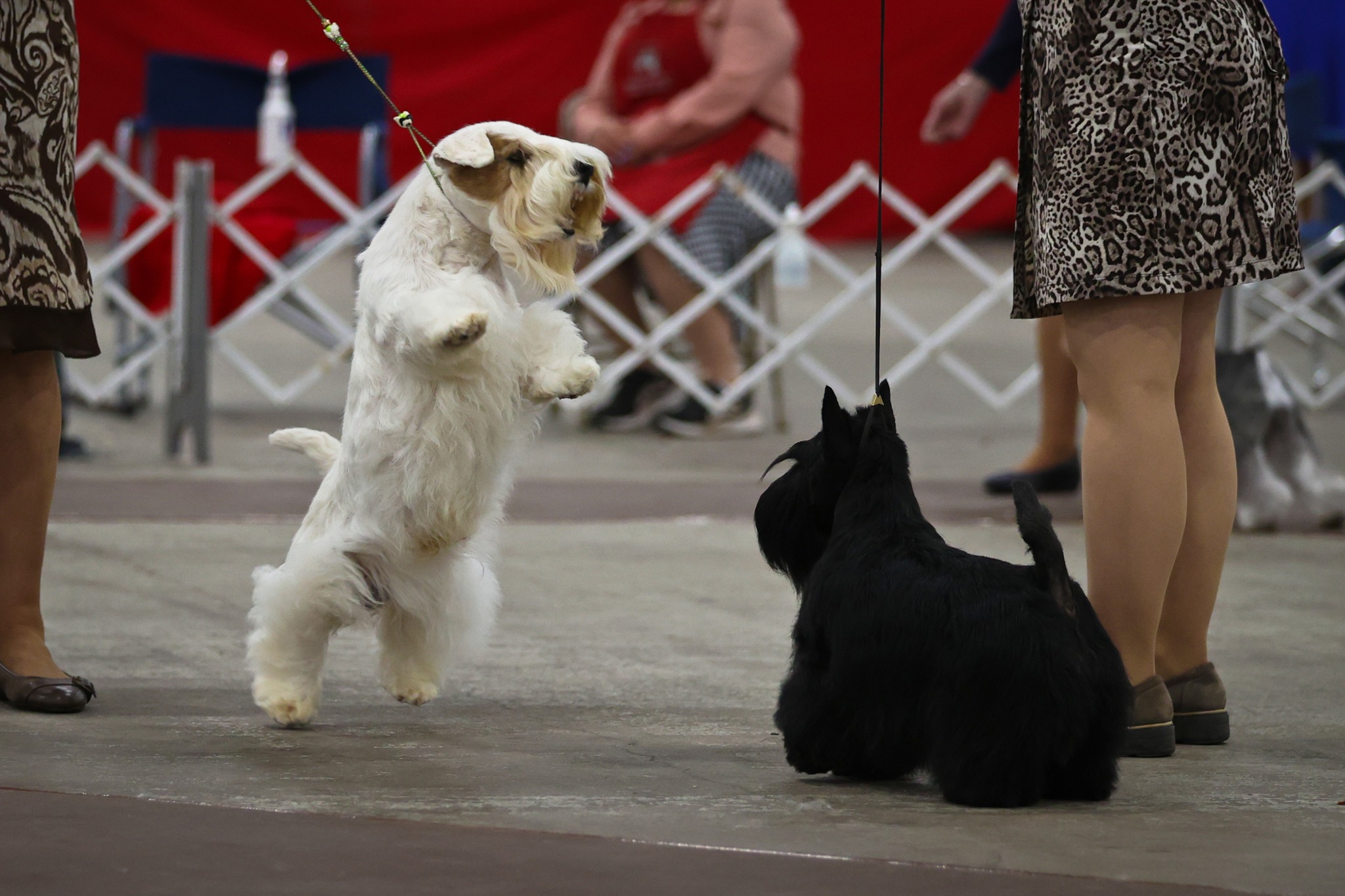
Stache sparring, showing the stand up character of the breed.
“They’re so generous. And all you need to do is ask and they will say what can I do for you. They’re very strong, sturdy, compact little dogs. They are big dogs just in a small package. They have very strong personalities. Their characters are very deep, as opposed to some of the other terrier breeds, whose characters are rather shallow. Which some people like. But it’s not for me. I like the depth of the character that I see in Sealyhams.
Classic Breeding Advice
“(Starting out) I was able to breed forward and not have a lot of faults that I had to breed away from. I had very good virtues to start with. In a breeding program, you need to concentrate virtues and minimize faults when you breed. So, you need to be able to see what a stud dog can give in virtues and what faults you might get and not double on what you have in your female. See what her strengths are and not double on the faults that they have. So, generation after generation, you do that. To the point of Stash, (GCHG CH Goodspice Efbe Money Stache, Terrier Group winner at the 2022 AKCNC) who’s the culmination of 50 years of my breeding.”
Listen to the entire conversation full of passion, insight and charm.
560 — Lessons from Orlando and Holiday Musings
Lessons from Orlando and Holiday Musings
The extravaganza of purebred dogs that is the AKC National Championship week in Orlando has come to a close. I skipped the last couple years with the pandemic and all that entailed, so it was really good to be back with the people I so rarely get to see.
I think we all learn something new each time… Like how it’s possible to walk 10 miles and never see the sky…. Or just how many shiny suits St. Johns actually makes…. Or what we jokingly refer to as “snacks in Orlando” … where a cheeseburger, an appetizer and two drinks costs $100….
But there are some actually useful lessons to be learned, some that happened to friends, some observed, some that have happened to me over the years, so here we go.
Wait, my dog is HIGH?
First up, dogs put ridiculous things in their mouths. Even at high-end hotels, be observant and careful when letting your dog roam free in the room. My friend Ingrid learned this lesson the very hard way this week when her Chihuahua found and ingested marijuana in a hotel room on her trip to Orlando. She is now extremely aware of the signs of cannabis toxicity in dogs….
This has become something of an epidemic at veterinary practices, according to Dr. Marty Greer. So, for those who haven’t experienced this, here are some tips. Also, take a listen to our past podcast on the topic of how cannabis can be useful in treating dogs in forms that do not contain THC.
Cannabis contains more than 100 different chemicals (or compounds) called cannabinoids. Tetrahydrocannabinol (THC) is the cannabinoid that has the most psychoactive effects. It is also the compound responsible for some of cannabis’ medicinal uses, such as treating nausea and improving appetite in cancer patients. Other compounds, such as cannabidiol (CBD), have shown promise for medicinal use and do not have psychoactive effects.
Dogs have more cannabinoid receptors in their brains, which means the effects of cannabis are more dramatic and potentially more toxic when compared to humans. A small amount of cannabis is all it takes to cause toxicity in cats and dogs.
Per VCA Animal Hospital, most of the signs of intoxication are neurological. Pets may become wobbly and uncoordinated. They may be hyperactive or sleepy, disoriented, and/or very vocal. Their pupils may dilate, giving them a wild-eyed appearance, and they may drool excessively or vomit. They may also develop urinary incontinence (i.e., urine leakage). In severe cases, tremors, seizures, and coma can result.
Physical signs include slow or fast heart rate, altered blood pressure, and slowed respiration rate (breathing rate). Lethargy and increases or decreases in body temperature may also be observed. Fortunately, these side effects are usually short-lived but they can still be dangerous and make your pet quite miserable.
Diagnosis is based on an accurate history and clinical signs. Although there are tests to determine the level of THC in the urine, the results take time, making them impractical. Human urine drug screening tests are quicker but are not dependable in pets. The diagnosis is made much more quickly, and treatment initiated, when responsible pet owners provide accurate information regarding the pet’s exposure.
When a toxin enters the body, often the first line of defense is to get it out. If the toxicity is discovered shortly after ingestion, your veterinarian may induce vomiting to prevent further absorption of the toxin.
Two factors may interfere with this early defensive strategy. First, the signs of toxicity may manifest only after the drug has been absorbed, meaning it is already in the system. Second, cannabis has an anti-emetic effect that inhibits vomiting. In life-threatening cases, the stomach may be pumped (gastric lavage). Activated charcoal may be administered every six to eight hours to neutralize the toxin. Enemas are also used to reduce toxin absorption from the gastrointestinal tract.
The second line of defense in cannabis toxicity involves providing supportive care until the effects of the drug wear off. Medications and supportive care to regulate your pet’s heart rate, respiration, and body temperature are used if needed. Since your pet may be lethargic, with no desire to eat or drink, IV fluids can help prevent dehydration, support blood pressure, and maintain organ function. Anti-anxiety medications can minimize agitation. Gastrointestinal treatments may be needed for nausea or vomiting. To prevent self-trauma while your pet is disoriented and uncoordinated, confinement in a safe, comfortable space is helpful. Noise should be kept to a minimum to decrease sensory stimulation.
If cannabis is ingested with toxic or problematic substances, such as xylitol, chocolate, raisins, or foods containing a lot of fat, supportive care or additional treatments may be required to treat conditions associated with the ingestion of those substances.
Pro Tip
Next, carpets are slippery! The AKC National Championship show, Westminster Kennel Club, and many of the biggest shows in the country feature beautifully carpeted rings to showcase the dogs. Experienced exhibitors know that dogs don’t move well on the carpet because their feet slip and they can’t drive off their rears. Even in a stack, dogs can have trouble holding their normal position. The best solution to this problem is to keep the dog’s feet wet. Spray bottles of water or wet towels will soften the hard pads enough to give the dog a grip on the carpet. This will allow you to showcase your dog to its best advantage on that gorgeous red carpet.
Your feet also need some consideration…. We’re putting in LOTS of hours on our feet… moving, standing, running, walking. Your entire body depends on those feet, so take care of them. Change shoes midday. Just the slightest shift in fit makes an enormous difference. I’m given rations of grief about my “shoe suitcase” but I promise, if I had taken better care of my feet when I was younger, it’s a good bet I’d live with less pain today…
Third, we would all do well to learn lessons from the best junior handlers in the country. They are supportive and outstanding sports, they cheer for each other, they encourage each other, they tease friends through bouts of nerves. They are composed under immense pressure, they are driven to succeed, they ooze talent and dedication. They may or may not be the future of the sport, but *their* futures will be immensely improved by the lessons they take away from the sport and incorporate in their daily lives.
We hear an awful lot about millennial this or teenage entitlement that, but when you see these young men and women working their butts off, sprinting over miles of concrete, competing at the highest level and often working ridiculous hours for handlers to support their dreams, you are left with a much different understanding of our youth. The best and brightest of these kids will shine no matter where their life’s journeys lead them.
Redemption is a Thing
Winston Churchill’s oft repeated quote is more fitting to our sport than most…
“Success is not final; failure is not fatal: it is the courage to continue that counts.”
Watching friends battle back from injuries, defeats, disappointments and setbacks has been inspiring for me, particularly this year. Kelly Shupp, who just handled our Spinone to win the Sporting group here, shattered her ankle in September and we really didn’t think she’d even be walking by this time. She fought through pain and frustration and disappointment and dedicated herself to being on the end of Josie’s leash to wrap up what had been a history making year already. Her strength and determination and sheer will power literally bring me to tears of awe.
Sharing is Caring
Whether it’s the YaYa Sisterhood of the traveling outfits when you win the group and didn’t expect to or a corner of a grooming space in a crowded building, this sport really can bring out the best in us. I treasure the people and friendships built over my lifetime in this sport.
I know there are Debbie downers out there, but I firmly believe that our lives are immeasurably richer when we focus on the positive and find the beauty around us. It’s lots easier to do that if you simply avoid and/or ignore the folks who would burst that bubble.
Big Trips are Exhausting
Having driven cross country innumerable times, in various vehicles, daunting weather and impossible schedules, I offer a few words of wisdom.
- Plan ahead. If something can go wrong, it will and at the most inconvenient time. Have backup plans for your backup plans. Pay attention to the weather apps. I used weather underground to route around upcoming storms. Adding an extra few hours or even a day to the trip to travel safely saved me countless headaches. Factor that into your planning. If you don’t need the extra day to arrive safely, you can always use it to relax and have a little fun on the journey.
- Sleep more and eat less. I always stop for a good night’s sleep. I need it to be safe on the road. And the dogs sleep better when the rig isn’t moving. I snack a lot when driving but rarely eat huge meals. I also stop every three to four hours to x dogs, get fuel, walk a little, stretch and keep the blood moving.
- Listen to a podcast! Lol
Thank YOU…
In closing, as we end the year of competition and transition into the holidays, I wanted to take this opportunity to thank you guys. It’s been 6 years now of talking to y’all. I was stopped this week by a lovely young man with a Barbet. He shared with me that the whole reason he was at the show was because of the work we do here. That he’d discovered the breed because of our episode with Judy Descutner. That the podcast gave him the tools and encouragement to stick with it. That brief conversation was the best gift ever.
And it’s those stories, YOUR stories, that keep me keepin’ on. So, thank you for taking us along …. On your road trips, your workouts, your grooming sessions, and your lawn mowing. I’m looking forward to a whole new year of sharing fabulous stories with you.
And I hope you’ll join us on the first Tuesday of every month for the live podcasts on the Facebook page, LIVE@5. If you haven’t had a chance, stop by Pure Dog Talk and join our Patrons getting their Pure Pep Talks.
348 — Juan Miranda: Survivor, Judge, Influencer
Juan Miranda: Survivor, Judge, Influencer
Juan Miranda, FCI’s youngest all-breeds judge, survived a car-jacking attack and returned to purebred dogs.
Miranda was just leaving his office in Mexico City five years ago, on his way to Westminster Kennel Club, when an armed assailant entered his new truck. Miranda struggled with the attacker, who shot him through the neck and face, missing his spinal cord by just three millimeters.
A year’s journey of healing saw Miranda in a “halo” device, relearning how to walk and all of the motor skills of life.
The only child of Afghan Hound breeders outside Mexico City, Miranda, won his first all-breed best in show with an Afghan at eight years old.
“I love Afghan Hounds. Their temperament is perfect for us. But we have had other breeds, including a Belgian Malinois who thinks she’s an Afghan,” Miranda said.
Miranda judged Afghans last year at the AKC National Championship sponsored by Royal Canin. This year he’ll participate in his favorite show in Orlando, as an exhibitor showing his own dog.
A popular “influencer” on Instagram, Miranda uses his position to promote the predictability and purpose of purebred dogs.
“The people from all over than world can learn, about us, dogs have a purpose to make life more easy,” Miranda said.
249 — Elliott Weiss, AKCNC BIS judge, on “Pleasing his Eye”
Elliott Weiss is Looking for the Dog that Makes the Picture

Elliott Weiss, BIS judge for the 2018 AKCNC.
In 1956, Elliott Weiss attended his very first dog show, Westminster Kennel Club, as part of an art class project.
Weiss spent 24 years as a top professional handler from 1969 through 1993. Among his big accomplishments, he handled the Irish Setter, Ch. Meadowlark’s Anticipation, to a Sporting Group win at Westminster in 1984. He started judging in 1994 and has judged all over the world. A native New Yorker, he now lives in Eagle, Idaho. His initial breed was Cocker Spaniels.
Make the Picture
“I want to please my eye,” Weiss said. “The first thing I’m looking for is a picture. I have a picture in my mind of every breed I judge.”
Weiss also noted that too many people bait the dog in such a way that their hands are in the way of the judge seeing the dog’s expression.
Amateur vs Professional
The Owner Handler-Professional Handler battle is nothing new, Weiss observed, it has been a big thing forever. “If you look back, there are always top winning owner handlers. The cream always comes to the top,” he said. “I think of Walter Goodman, Pat Craige (Trotter)… Sunny Shay.”
Mentor the Future
“I think we don’t do enough for junior handlers,” Weiss said. “We need to teach them conformation, have them join clubs, offer Junior workshops. I think we should start thinking how we can increase the sport in 5-10 years, not tomorrow.”
That ONE Dog
After 60 plus years in the sport, the dog who stands out, to this day, in Weiss’ mind is George Alston’s English Foxhound, Winslow (Ch Mr Stewar’s Cheshire Winslow, hound group winner in 1984). “I watched this dog walk into the ring and I froze. I put down my brush and just looked at him. Everything flowed into the next piece.”
Watch Weiss judge Best in Show at the nation’s largest dog show on national television. AKC National Championship presented by Royal Canin will be broadcast New Year’s Day, at 6 p.m. ET/PT on Animal Planet.
Learn more:
144 – Stars in Orlando|Jason Taylor and Jerry O’Connell
Jason Taylor and Jerry O’Connell – Stars in Orlando
Jason Taylor is the face you rarely see behind the scenes of the AKC National Championship presented by Royal Canin. Taylor, an Afghan Hound breeder who worked for Eukanuba before the show even existed, is a constant through the year’s 18 year history.
“I think the thing we got right early on,” Taylor said, “was the focus on celebrating breeds and breeders. It’s why we have the Bred By Exhibitor competition that continues to today. The other thing is, there are no tiny rings at the AKC National Championship. We believe you need to be able to see dogs move. At least for this show, this is the way it’s gonna be.”
Assistant Show Chairman – Jason Taylor
Taylor’s official title is Assistant Show Chairman and National PRO Sales Director for Royal Canin. He also is the force behind this year’s hugely successful roll out of the puppy/junior sweepstakes event on the Friday of the National Championship events weekend.
“We liked the idea of introducing a moment celebrating the future stars,” Taylor said. “When I sat down and drafted the event, working with Gina DiNardo, we thought if we could get 500 puppies it would be a success. It was beyond any dream that we got 1200 entries!”
Taylor admits the team had concerns, with a focus on dogs first, that the “big, busy week” would overwhelm the young dogs. But he notes that exhibitors were mindful of the puppies’ needs and careful with them.
The wild schedule of that Friday in the weekend is one Taylor also went into aware of the potential issues. “But we think of these as good problems to have,” Taylor said, observing the record-breaking entry for the event. Friday features the National Owner-Handled Series, 30 specialties, including several nationals and two group shows. Adding the Puppy/Junior event was additional pressure on the schedule.
“On paper it looked like conflicts,” Taylor said. He even joked about the building-wide “brown out” that effectively juggled the schedule enough to squeak through with fewer head to head conflicts than expected. “We learned a lot,” Taylor said. “There are some tweaks we can make to relieve the schedule.”
Taylor’s Wisdom for Show-Giving Clubs
And, just for Pure Dog Talk listeners, Taylor offered the benefit of his wisdom as applicable to all show-giving clubs.
“The AKC National Championship is unique,” Taylor observed. “But the principles are the same. You have to concentrate on revenue, but it can’t solely be from entries. Clubs have to get creative and think outside the box.
“And they need to be absolutely maniacal about expenses. Make sure the money you spend is in the right places. That it’s going to show up.
“Clubs need to generate awareness. Too many clubs don’t know how. There are newspapers, blogs, podcasts. There are individuals in every market who are into dog things. Facebook pages are critical. Clubs need to reach out to the community. Even if folks are not dog show people, they’ll come out for dog stuff. The more people who attend a show, the happier the vendors are and so on.
“Dog shows are hard (for the general public). Most of the activity is at 8 a.m. and slows down through the day. For most families, their day happens in the opposite way. Having things for people to do, to get involved with, is vital.”
Jerry O’Connell Co-Host’s on Animal Planet
After our talk with Taylor, Laura had a few minutes to catch up with the show’s newest co-host, Jerry O’Connell, known for his work on the film Stand By Me and Crossing Jordan.
Listen in to our up close and personal visit with O’Connell. Hear his exclamations that the dogs are adorable and well-behaved, his experience with being groomed at the dog show, his commentary on where women store their bait and more.
“I’m the guy they bring in to ask the questions the people at home want to ask,” O’Connell noted. “It’s impossible not to smile walking across that floor.”

